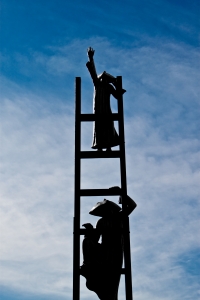Many employers throughout Boston are well aware of the requirements set by the Occupational Safety and Health Administration regarding fall protection equipment. Yet, falls remain a top cause of workplace injuries and deaths, especially in the construction field. One possible reason why falls often cause serious or even fatal injuries is because many employers’ fall protection plans do not go far enough. Employers need to not only take steps to prevent falls but also should have a plan in place for what happens after the fall. 
Recently, Safety BLR published a comprehensive article on the importance of having a rescue plan in place in case a fall occurs. A rescue plan could allow an employee to get more timely assistance so his injuries are less likely to be devastating or deadly. Those who do suffer falls can make a workers’ compensation claim with the help of a workplace accident lawyer, and employers can cut their costs for work-injury benefits by ensuring that workers get the most prompt treatment for injury.
A Rescue Plan After Fall Injuries
When a worker is using a fall protection system, he could face serious injury or death even when he does not experience visible trauma after taking a tumble. Prolonged suspension can cause suspension trauma and orthostatic intolerance because the legs may be kept immobile and lower than the heart by the fall arrest system.
OSHA understands the dangers associated with a delayed rescue after a fall. Under 29 CFR 1926.502(d) related to fall protection systems criteria, OSHA has established a rule that employers must provide prompt rescue of employees if a fall occurs. Rescue procedures should be identified that allow a worker to rescue himself or that ensure someone is there to help.
OSHA does not specify a specific time limit in which a rescue has to be carried out to comply with the requirements. However, research has indicated that being suspended in a fall arrest device could cause unconsciousness and then death in less than a half hour. A worker is at risk as soon as he is unable to move for five minutes or more. While tolerance for being in a fall arrest system can vary from person to person, negative effects generally start to set in very quickly.
Rescue plans can be simple to create, but knowing what to do in advance is key. When a worker is not able to self-rescue after a fall, the rescue plan should include:
- Having rescue equipment such as ladders, additional harnesses or controlled descent devices present at the workplace.
- Having emergency contact information for a professional rescue service, such as the local fire department, available and alerting the department when undertaking a project that has the potential for fall injuries to occur.
- Identifying obstructions that could be in the way of rescuing a worker who is suspended in a fall protection system.
The goal of the rescue plan should be to ensure that rescue will be possible within 15 minutes of a fall occurring so that the risk of suspension trauma or further injury is minimized.
If you are injured on the job in Massachusetts, call Jeffrey Glassman Injury Lawyers for a free and confidential consultation to discuss your workers’ compensation claim– (617) 777-7777.
More Blog Entries:
Workplace Injury Often Result of Fatigued Employees, March 29, 2014.
 Massachusetts Workers Compensation Lawyers Blog
Massachusetts Workers Compensation Lawyers Blog

